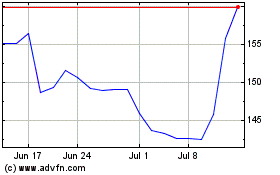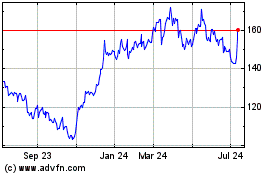By Chris Kirkham
At Paradise at Ironwood Crossing, a 2,100-home master-planned
community southeast of Phoenix, new houses starting as low as
$170,000 are snapped up within weeks of hitting the market.
The starter homes in this suburban enclave are among the most
affordable in the metro area, said Dennis Webb, vice president of
operations at builder Fulton Homes, and are among the company's top
sellers.
But escalating land prices and local development fees mean that
continuing to build new homes in that price range is no longer
viable, Mr. Webb said.
"There's not enough profit to be made on that entry-level
house," he said.
Across the U.S., new-home construction has remained at
historical lows throughout the housing recovery of the last five
years, but the share of starter homes priced below $200,000 has
dwindled more than any other segment, according to U.S. Census
data.
New homes under $200,000 made up 19% of U.S. sales last year,
down from 38% four years earlier. By contrast, homes sold between
$300,000 and $500,000 accounted for 34% of new home sales last
year, up from 22% in 2011.
Data from real-estate tracker Trulia shows a similar trend: The
share of new homes built in the bottom third of price distribution
shrank from 16% of the market in 2000 to 7.9% by 2015. New homes in
the top third of the price distribution grew from 57% of total
construction in 2000 to nearly 69% last year, according to an
analysis by Ralph McLaughlin, the group's chief economist.
The shift reflects drastic changes in the business of home
building and the profile of buyers since the housing bust,
developers said.
Many builders ventured to the far fringes of the suburbs in the
mid-2000s in search of cheap land for a seemingly endless pool of
buyers. When the housing market tanked the value of that land
plummeted as demand dried up.
At the same time, tightened lending standards in recent years
have had the biggest impact on first-time buyers, effectively
leaving them on the sidelines. That prompted builders to cater to
demand from buyers who could afford larger, pricier homes.
Many surveys show millennials still eventually aspire to
homeownership in the suburbs, but they are waiting until later in
life to purchase homes than previous generations.
Although many major builders, particularly D.R. Horton Inc.,
have once again started marketing to first-time home buyers over
the last two years, that share of overall home buyers remains at a
nearly three-decade low of 32%, according to the National
Association of Realtors.
"The move-up market has been much more profitable per house than
the entry level," said housing economist Brad Hunter, chief
economist at HomeAdvisor, an online home services marketplace.
"Builders decided 'Well, let me deploy my resources where I can get
the best return.'"
Adding to the complication: Land prices have shot up as the
economic recovery has progressed, further driving up the minimum
price points for new homes as builders compete for prime lots that
are closer to job centers.
Although land remains the least expensive on the periphery of
major metro areas, many builders have been hesitant to pursue
projects in those areas, mindful of how that strategy backfired a
decade ago.
Across the U.S., prices for finished lots are nearly back to the
peak levels of 2006, according to the most recent figures from John
Burns Real Estate Consulting of Irvine, Calif. Values for finished
lots have increased 59% since the market bottomed in 2009,
according to an index of lot prices throughout the country.
In popular suburbs of Dallas, such as Frisco, Texas, prices for
lots have increased from $50,000 to as much as $120,000 over the
same period, according to builders and developers in the area.
In markets such as Dallas, Austin and Denver, lot prices have
surpassed previous peaks. Even hard-hit markets such as Phoenix are
nearly back to the lot prices of the boom years.
Some major publicly traded builders such as Lennar Corp., D.R.
Horton and Standard Pacific Corp. (now CalAtlantic Group Inc.)
snapped up cheap land when prices hit bottom in 2009 and 2010. But
many other builders started acquiring land only as the recovery
picked up in 2013, when lots were more expensive.
"If you were buying land at significantly higher prices, you
immediately prevented yourself from building a lower-priced product
on that land," said Rick Palacios Jr., director of research at John
Burns Real Estate Consulting.
The land at Paradise at Ironwood Crossing outside Phoenix, for
example, was purchased by Fulton Homes a decade ago at a lower
price point. That allowed for more flexibility in the asking
prices.
Marianne Lubich said she was thrilled to find the home she moved
into last September with her son, less than a half-hour from work
and just 10 minutes away from a major shopping area. She had looked
closer to her office in Chandler, Ariz., but a new home would have
cost too much -- even existing homes were pricey.
"I'm like 'Geez, I can get a brand new home for this price?"
said Ms. Lubich, whose final price tag came to about $212,000, with
several upgrades. "I got a lot for my money."
Donnie Evans, president of Altura Homes in the Dallas area, said
increased land and permitting costs in many Dallas suburbs have
taken a chunk of prospective buyers out of the market over the last
two years. Homes at the lowest end that his company used to sell
for $120,000 two years ago are now going for $190,000, and so on up
the chain.
"Home building is like a pyramid: The lower you go, the bigger
your base is," Mr. Evans said. But the only way to make such deals
work is to go to the far edges of the metro area, he said -- areas
up to 50 miles from job centers.
Not all builders have shied away from the entry-level segment.
D.R. Horton introduced a concept called Express Homes about two
years ago. That division has come to represent nearly a quarter of
the company's home deliveries and 16% of home sales revenue. These
houses, priced as low as $130,000 in some parts of the south,
feature basic floor plans without extra options or upgrades -- a
"turnkey operation," as the company calls it. Such standard designs
allow the company to build homes at a faster pace, increasing sales
volumes and controlling costs .
But the scale of Express Homes and LGI Homes, another
entry-level builder, is limited to certain regions -- mainly Texas,
parts of the South and low-cost areas of California such as the
Central Valley -- where the difference between the low end and the
high-end isn't as wide. Most of the developments are farther away
from primary job centers in more expensive markets, such as the Bay
Area and Denver, and fewer in number so far.
"That is a small piece of the country," said George Casey, a
former home building executive and chief executive of consulting
firm Stockbridge Associates. "You can't do what they do
everywhere."
Other builders have suggested the market for traditional starter
homes, a quintessentially American concept dating back to soldiers'
return from World War II, might be changing with generational
preferences. A recent survey from Bank of America found that 75% of
first-time home buyers would bypass a starter home for one that
would meet their long-term needs, even if it meant waiting.
"Having a first-time home buyer market is very, very important,"
said Pat Hamill, chief executive of Oakwood Homes in the Denver
area, because it allows buyers to progress upward through the
system, building equity along the way that can be used to purchase
a larger or more desirable home.
"I don't know what happens when you take that segment out of the
marketplace."
Write to Chris Kirkham at chris.kirkham@wsj.com
(END) Dow Jones Newswires
May 06, 2016 06:00 ET (10:00 GMT)
Copyright (c) 2016 Dow Jones & Company, Inc.
Lennar (NYSE:LEN)
Historical Stock Chart
From Mar 2024 to Apr 2024

Lennar (NYSE:LEN)
Historical Stock Chart
From Apr 2023 to Apr 2024
